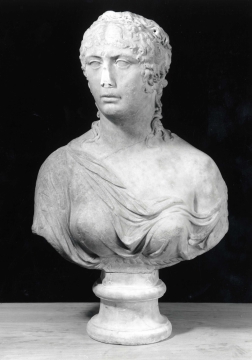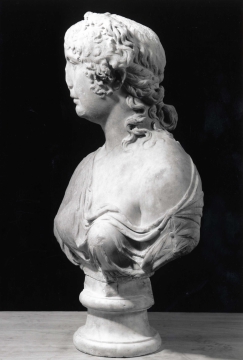Explore Collections


You are here:
CollectionsOnline
/
Portrait of a Roman lady
Browse
Portrait of a Roman lady
20-50 AD
Medium-grained Greek marble
Height: 74cm, maximum
Height (from bottom edge of bust): 63cm
Height (from bottom edge of bust): 63cm
Museum number: M779
On display: Dome Area
All spaces are in No. 13 Lincoln's Inn Fields unless identified as in No. 12, Soane's first house.
For tours https://www.soane.org/your-visit
Curatorial note
The head is turned towards the right, and the glance, with pupils unexpressed, is a little lowered. The rich hair, daintily curled, forms a knot (korymnos, mostly weathered away) on the top of the head, and falls in ringlets on the neck and shoulders. It is turned under in a bound roll at the back. The chiton-like garment is fastened in five places along the right shoulder and upper arm and is arranged over the full breasts so as to leave the left shoulder exposed.
The unusual form of this bust, the head strongly reminiscent of Julio-Claudian female portraiture (particularly the bust of Clytiè in the British Museum1) and the bust itself, a type more associated with the second century, led to Poulsen's condemnation of this bust as a forgery 'with well-imitated disintegration of surface' as against Michaelis' and Bernoulli's acceptance of it as genuine. The close stylistic similarity between details of this bust and similar details of the Clytiè (the treatment of the curls on the shoulders, in the arrangement of drapery over the full bosom, and the fastenings of the chiton on the right shoulder) show that this Soane bust must not be condemned on individuality of presentation alone. If it is a forgery, then an eighteenth century 'bust' from Cavaceppi and now in the Berlin Museum is its derivation2.
The high quality of this idealisation of a younger woman with strongly defined features, the convincingly ancient surface, and the restorations that have been made totally without any attempt at deception, all argue the genuine and highly individual antiquity of this colossal bust. The portrait is of a lady of the period of Tiberius, Caligula, or Claudius (20-50 AD), probably a member of the Imperial court circle or a prominent Roman family. The lack of positively documented busts or coin-portraits from the Roman home mints makes identification as Agrippina Junior3, one of the other sisters of Caligula, or Messalina, the Wife of Claudius, too hazardous on a comparative basis.4 Although this bust seems securely anchored in the Julio-Claudian period these exceptional, usually over-lifesize, busts of Roman ladies of rank have a certain timelessness about them, a style which persisted through the third century5 and into the fourth (in statuary, compare with the seated female in the Museo Capitolino, Rome, identified by Mme R. Calza as Helena). In 'Studies in Julio-Claudian Iconography'6, F. H. Poulsen reminds us that Agrippina Junior, whom Bernoulli saw in this bust, was the subject of posthumous heroization, as proved beyond dispute by the colossal head found in the Mercato Traiano, Rome. Given the existence of that portrait of the Claudian Empress in heroic dimenions, it is perhaps possible to reconcile a second century dating for the 'type' of this bust for those who cannot accept it as a first century product.
The arrangement, type and method of buttoning the chiton on the right shoulder is taken directly from Greek dress of the fifth century BC, as seen from the grave relief of a priestess from the Dipylon in Athens7 and the long girt chiton of the young female in a relief fragment from Smyrna in the Louvre.8
Careful comparisons with the portraits mentioned above do not give a satisfactory answer as to who is depicted in the Soane bust and it must remain the portrait of an unknown, probably courtly lady of the Julio-Claudian period.
The nose was remodeled in plaster by Martin Holden in 1991, based on comparable portraits. His remodelling replaced an ealier restoration, which was much decayed.
1 British Museum, Marbles and Bronzes, pl. 35; no. 1874. H. Jucker, Das Bildnis im Blätterkelch, Lausanne 1961, I, pp.65-66, II, figs, 17-18.
2 Blümel, Römische Bildnisse, p. 48f., pls. 75, 76; G. Bovini, in Monumenti Antichi, 1943, p.116f.
3 On the portraits of Agrippina Minor, see F. Poulsen, Les portraits romains, I, Copenhagen, 1962 and 1974, pp. 96-98, nos. 61-63. The Soane bust might well represent Antonia Minor, wife of Nero Drusus and mother of Germanicus and Claudius: as F. Poulsen, op.cit., 77-79, under no.42.
4 See J.J. Bernoulli, Die Römische Ikonographie, II, p. 180ff.
5 Compare the Salonina in the Hermitage: Bovini, loc. cit., p. 237.
6 Acta Archaeologica (Copenhagen), 1946, pp. 41ff.
7 Heinrich Bulle, Der Schoene Mensch im Altertum, 1912, pl. 269.
8 Margarete Bieber, Griechische Kleidung, Berlin-Leipzig, 1924, pl. IX, 2.
The unusual form of this bust, the head strongly reminiscent of Julio-Claudian female portraiture (particularly the bust of Clytiè in the British Museum1) and the bust itself, a type more associated with the second century, led to Poulsen's condemnation of this bust as a forgery 'with well-imitated disintegration of surface' as against Michaelis' and Bernoulli's acceptance of it as genuine. The close stylistic similarity between details of this bust and similar details of the Clytiè (the treatment of the curls on the shoulders, in the arrangement of drapery over the full bosom, and the fastenings of the chiton on the right shoulder) show that this Soane bust must not be condemned on individuality of presentation alone. If it is a forgery, then an eighteenth century 'bust' from Cavaceppi and now in the Berlin Museum is its derivation2.
The high quality of this idealisation of a younger woman with strongly defined features, the convincingly ancient surface, and the restorations that have been made totally without any attempt at deception, all argue the genuine and highly individual antiquity of this colossal bust. The portrait is of a lady of the period of Tiberius, Caligula, or Claudius (20-50 AD), probably a member of the Imperial court circle or a prominent Roman family. The lack of positively documented busts or coin-portraits from the Roman home mints makes identification as Agrippina Junior3, one of the other sisters of Caligula, or Messalina, the Wife of Claudius, too hazardous on a comparative basis.4 Although this bust seems securely anchored in the Julio-Claudian period these exceptional, usually over-lifesize, busts of Roman ladies of rank have a certain timelessness about them, a style which persisted through the third century5 and into the fourth (in statuary, compare with the seated female in the Museo Capitolino, Rome, identified by Mme R. Calza as Helena). In 'Studies in Julio-Claudian Iconography'6, F. H. Poulsen reminds us that Agrippina Junior, whom Bernoulli saw in this bust, was the subject of posthumous heroization, as proved beyond dispute by the colossal head found in the Mercato Traiano, Rome. Given the existence of that portrait of the Claudian Empress in heroic dimenions, it is perhaps possible to reconcile a second century dating for the 'type' of this bust for those who cannot accept it as a first century product.
The arrangement, type and method of buttoning the chiton on the right shoulder is taken directly from Greek dress of the fifth century BC, as seen from the grave relief of a priestess from the Dipylon in Athens7 and the long girt chiton of the young female in a relief fragment from Smyrna in the Louvre.8
Careful comparisons with the portraits mentioned above do not give a satisfactory answer as to who is depicted in the Soane bust and it must remain the portrait of an unknown, probably courtly lady of the Julio-Claudian period.
The nose was remodeled in plaster by Martin Holden in 1991, based on comparable portraits. His remodelling replaced an ealier restoration, which was much decayed.
1 British Museum, Marbles and Bronzes, pl. 35; no. 1874. H. Jucker, Das Bildnis im Blätterkelch, Lausanne 1961, I, pp.65-66, II, figs, 17-18.
2 Blümel, Römische Bildnisse, p. 48f., pls. 75, 76; G. Bovini, in Monumenti Antichi, 1943, p.116f.
3 On the portraits of Agrippina Minor, see F. Poulsen, Les portraits romains, I, Copenhagen, 1962 and 1974, pp. 96-98, nos. 61-63. The Soane bust might well represent Antonia Minor, wife of Nero Drusus and mother of Germanicus and Claudius: as F. Poulsen, op.cit., 77-79, under no.42.
4 See J.J. Bernoulli, Die Römische Ikonographie, II, p. 180ff.
5 Compare the Salonina in the Hermitage: Bovini, loc. cit., p. 237.
6 Acta Archaeologica (Copenhagen), 1946, pp. 41ff.
7 Heinrich Bulle, Der Schoene Mensch im Altertum, 1912, pl. 269.
8 Margarete Bieber, Griechische Kleidung, Berlin-Leipzig, 1924, pl. IX, 2.
Probably acquired by Soane from the sale of the effects of the sculptor Joseph Nollekens, Christie's, 4 July 1823, Lot. 95, 'Bust of Berenice', marked in Soane's copy of the sale catalogue as bought for 11 guineas (purchased on the 2nd day of the sale i.e. 5th July 1823). Note that this lot was amongst a group of Lots containing 22 marbles 'From the Lower Workshop', perhaps implying that Nollekens may have worked on them or been planning to work on them himself.
Literature
Frederick Poulsen, Les portraits romains, p. 26, no. 9.
Johann Jakob Bernoulli, Römische Ikonographie, II, p. 191, no. 47.
A. Michaelis, p. 475, no.14.
H. Jucker, Das Bildnis im Blätterkelch, Lausanne 1961, I, pp.65-66, II, figs, 17-18.
Susan Walker, 'Clytie - a false woman?' in Mark Jones (ed), Why Fakes Matter, London 1993, p. 33, figs. 3 & 4.
Johann Jakob Bernoulli, Römische Ikonographie, II, p. 191, no. 47.
A. Michaelis, p. 475, no.14.
H. Jucker, Das Bildnis im Blätterkelch, Lausanne 1961, I, pp.65-66, II, figs, 17-18.
Susan Walker, 'Clytie - a false woman?' in Mark Jones (ed), Why Fakes Matter, London 1993, p. 33, figs. 3 & 4.
Soane collections online is being continually updated. If you wish to find out more or if you have any further information about this object please contact us: worksofart@soane.org.uk















